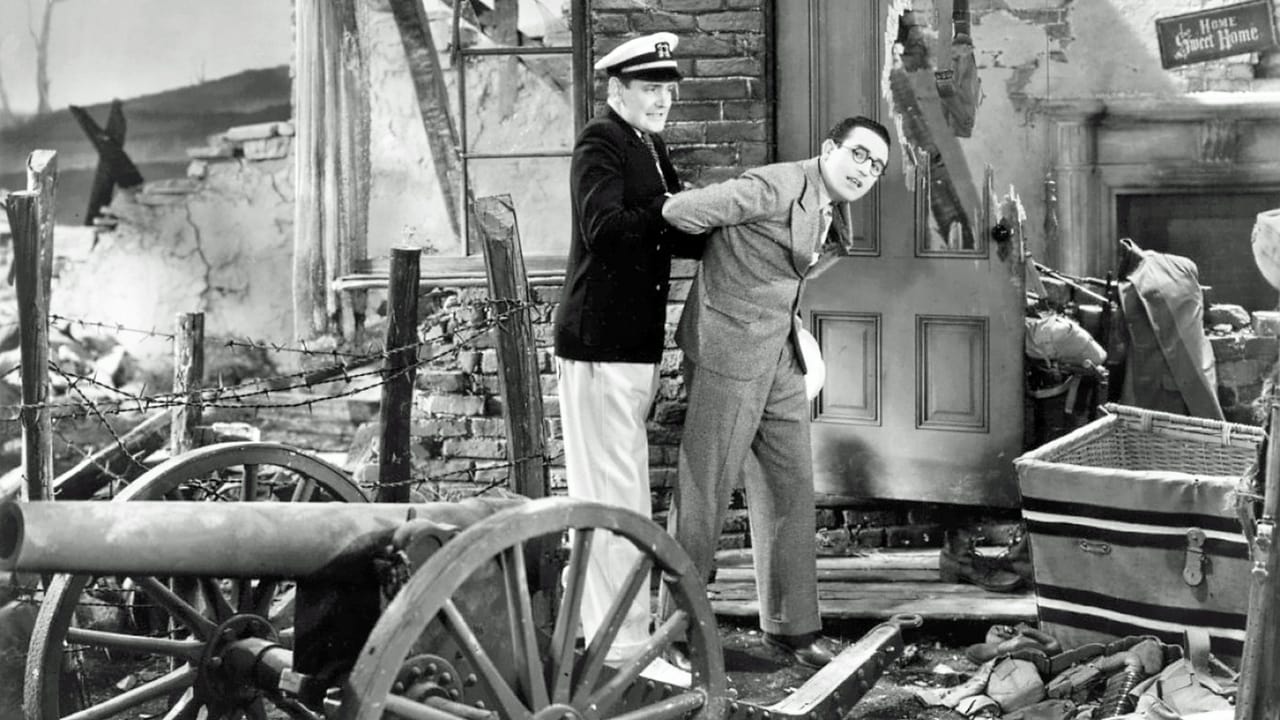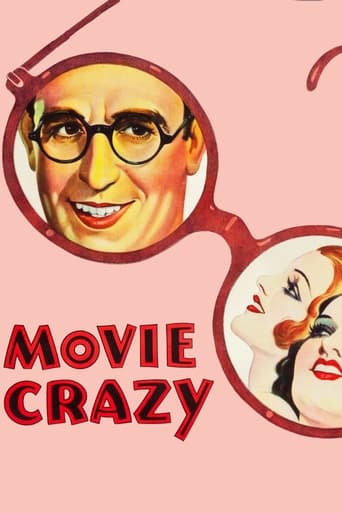IslandGuru
Who payed the critics
StunnaKrypto
Self-important, over-dramatic, uninspired.
Spoonixel
Amateur movie with Big budget
SpunkySelfTwitter
It’s an especially fun movie from a director and cast who are clearly having a good time allowing themselves to let loose.
Bill Slocum
The advent of sound hit Harold Lloyd like a well-thrown pie, even if he maintained his box-office appeal for a while. Proof of that is this, his best-regarded sound picture.Harold Hall (Lloyd) is a clumsy clod from the Midwest who dreams of making it big in Hollywood. After sending by accident someone else's photograph to a big studio, Harold is happily surprised to cadge an invite to Tinseltown. But getting there is one thing; does Harold have what it takes to stay there?I can't say I hated everything about "Movie Crazy;" the opening score is buoyant and energetic. Most reviewers point to Constance Cummings' dynamic turn as an actress who takes a fancy to Harold; she is every bit as amazing as they say. But man this film makes Lloyd look bad!Lloyd was a comic performer of great subtlety and inventiveness; qualities absent from what he delivers here. With his too-earnest delivery and prim inflections, he makes an odd impression as he overacts every big line. "When I come back, I'll come rolling in a Rolls-Royce," he tells his parents.Worse, as with "Feet First" he plays an idiot, a far cry from the capable, sympathetic clown he essayed in silents. Sound transformed Buster Keaton into the dolt "Elmer;" here Lloyd works a lot of double takes and plays up his character's naïve stupidity at nearly every turn. Much of the comedy here involves Harold tripping over himself, oblivious to the world around him.This works in his favor with Cummings' Mary Sears character, charmed by his stumbling and the fact he hasn't come on to her like every other guy in town. She nicknames him "Trouble" and plays a mean but funny trick on him, by playing up Harold's confusion that the Spanish bombshell she portrays in her latest movie is somebody else, not her.I'd like "Movie Crazy" a lot more if they knew what to do with this inspired idea. Cummings has fun with the dual performance, and there is a fine scene where Harold approaches Mary in her Spanish disguise to get his pin back, so he can give it to Mary. She urges him to give her a good-bye kiss first, asking him how this Mary could know."Believe me, she sees everything!" Harold replies.But instead of going in a screwball direction with this, Mary becomes genuinely hurt when her ruse works too well, and Harold is hurt in turn. The film limps on like this for another 30 minutes.I think I know what the matter was with Lloyd and sound. In silents, he played an archetype, an engaging one that captured the zeitgeist of the time and meshed with the kind of physical comedy he perfected. But sound pushed him to play more of a character, with realistic reactions, and it was too much.To compensate, Lloyd oversold the clowning, to the point where every other motion leads to a pratfall or a crash. This makes it much harder to root for sound Lloyd than it was for silent Hal.Lloyd also directed the film, uncredited, and shows some characteristic visual flair setting up shots. As long as he focuses on Cummings, he holds my attention. But it's not really a case of the actress upstaging the star; it's more like nature abhorring a vacuum. By the way, a vacuum is the one gag prop that doesn't show up here.
Neil Doyle
Stripping MOVIE CRAZY of its awkward dialog and reducing the running time to perhaps an hour and fifteen minutes, would have improved the film considerably. HAROLD LLOYD seems a bit ill at ease in a role clearly meant for a much younger man, but CONSTANCE CUMMINGS is assured and poised in what is, unfortunately, an unlikeable role. Her manipulative and scheming ways when she decides to play a trick on him, makes the character colder than it ought to be in a comedy of this sort. Thus, the happy ending for their relationship seems contrived.Some of the physical comedy and sight gags are worthy of a better film and makes me think that the whole story would lend itself better to the silent comedies Lloyd made before the advent of sound.I liked the rainy day scene with the convertible top refusing to operate properly--and his efforts to improve the situation only making things worse. His relationship with the heroine gets off to a bumpy start right then and there.But that's the trouble with the whole film. His hapless inability to do anything right gets tiresome by the time he's practically demolished every set piece in sight. The cleverest bit comes at the fancy dinner where he inadvertently puts on the wrong jacket belonging to a magician. Somehow, mice, bunnies and eggs keep popping out while he's trying to dance with an executive's wife--and, of course, it's the sort of thing Lloyd carries off effortlessly, without words.I enjoyed other Lloyd comedies from simpler times, without a weak script offering dull dialog. This is probably why the last big scene without need of talk provides the best moments--a big fight on a studio set between Lloyd and KENNETH THOMSON, his rival for Cummings. It's staged brilliantly and at least gives the story a wallop for the ending that it seriously needed.Otherwise, the overall effect would have been a bit tedious.
MARIO GAUCI
This is surely Harold Lloyd's most satisfactory Sound film and, while it's hardly ever discussed in this context, one of the best comedies to emerge in the early Talkie era. As a matter of fact, ill-fated director Clyde Bruckman was a master handler of comedy (before booze got the better of him!) who guided the likes of Buster Keaton, W.C. Fields and Lloyd himself through some of their finest vehicles.Anyway, the film finds the star at perhaps his most accident-prone - while the enchanting Constance Cummings is easily the strongest (and most talented) leading lady Lloyd ever had! As the title suggests, it provides a rare behind-the-scenes look at a Hollywood studio during its Golden Age and features a running-gag with Harold falling foul of a pompous studio executive. However, the film also involves typical situations for him such as mistaken identities (Lloyd unwittingly sends out to Hollywood the photo of a handsome guy, Cummings 'doubles' as a Spanish diva who ensnares our hero), romantic complications (the couple's frequent break-ups occurring as much through the intrusion of a rival as by the stars' individual character flaws) and disillusionment (Harold believes his disastrous screen-test was a triumph).Amazingly, according to the IMDb, the film was shot with a Silent-movie camera to re-create the trademark Lloyd technique - with the the dialogue and sound effects added in post-production: sure enough, the energetic fistfight which caps the picture is highly reminiscent of the extended climactic bout in THE KID BROTHER (1927); similarly, the havoc caused by a magician's coat mistakenly worn by Harold during the uproarious party sequence recalls the suit-ripping gag from THE FRESHMAN (1925) - this scene, then, features very brief bits by amiable character actors Grady Sutton (as an overtly effeminate guest scared by a roaming mouse) and Arthur Housman (as, you've guessed it, a drunkard).By the way, I wasn't aware that the PAL VHS released by the British Film Institute I previously owned (and which is how I had watched it) was actually the 80-minute re-issue version - though I couldn't quite tell what constituted the 'new' material!
Ron Oliver
A MOVIE CRAZY young klutz comes to Hollywood and tries to become a film star in the worst possible way.Harold Lloyd had a solid success with this, his third talking film. Not only is he still a very funny fellow with outstanding athletic abilities (especially considering that half of his right hand was a prosthetic) but the film itself is remarkable for its feeling of natural realism. It doesn't look or sound like most of its other contemporaries. The dialogue has a true ring to it and much of the acting is perfectly straightforward & unaffected. Much credit must go to the fine work done by the director, writer & cameraman.The production values are of a very high order, offering glimpses of back lot Paramount Studios as a bonus. Harold's gags are often hilarious and he has some tremendous sequences, creating unintended havoc about the movie lot, attending a fancy dance party while wearing a magician's coat maliciously intent on disgorging its contents, or engaging in a climactic battle with the bad guy around a flooded set.Constance Cummings, as the actress who captures Harold's heart, gives a remarkably naturalistic performance, sweetly bringing the viewer under her spell. You want Harold to fall for her, even while he only has eyes for her Latin alter ego. Here is a performer who deserves to be rediscovered.DeWitt Jennings & Lucy Beaumont are enjoyable in their very short opening sequence as Harold's Kansas parents. Kenneth Thomson, as the villain of the film, is effective as the drunken brute who wants Miss Cummings for himself. Spencer Charters is fun as a highly temperamental studio executive. Arthur Housman is on hand playing the patented inebriate he performed so often. And marvelous Louise Closser Hale shines in her only scene as a Hollywood matron who shares a disastrous dance with Harold.Movie mavens will recognize Noah Young, a familiar face from Harold's silent films, as an upset cop & a hilarious Grady Sutton as a nervous fellow who's terrified of mice--both uncredited.

